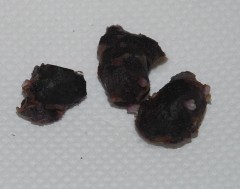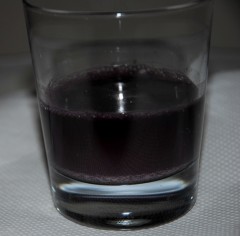Sep 04, 2010
Superfood from our forests
The latest craze in the US is black rice, touted as a superfood because of its high anthocyanin content. Here's an article from Yahoo! News.
Wait till these direct sales marketers and health food companies get hold of our black kunyit.



NOTE 22/7/2012 : TWO READERS OF THIS BLOG, ONE FROM HAWAII, AND ANOTHER FROM LANGKAWI, PAK DIN, http://herbwalk-langkawi.com.my/thewalk.html HAVE IDENTIFIED THIS PLANT AS Kaempferia parviflora, A PLANT FOUND IN NORTHERN THAILAND AND USED EXTENSIVELY FOR TRADITIONAL MEDICINE. THANKS TO BOTH FOR HELPING OUT.
THE PLANT WAS FOUND IN A FOREST NEXT TO OUR FARM. WE TAKE NOTE THAT THE FOREST IN QUESTION IS BOUNDED ON THREE SIDES BY FARMS AND ON ONE SIDE BY A FOREST RESERVE. WE CAN ONLY SPECULATE HOW IT WAS INTRODUCED INTO THE FOREST, THOUGH WE MUST ADMIT IT SEEMS EXTREMELY WELL ADAPTED TO THE CONDITIONS LOCALLY AND WE HAVE NEVER SEEN ANY DISEASE AFFECTING THE SAID PLANT.
11:04 Posted in Useful Plants | Permalink | Comments (2) | Tags: black turmeric, kunyit hitam, temu hitam, kali haldi, curcuma aeruginosa, curcuma caesia








Comments
I am an overseas student who studying master degree at Tsing Hua University in Taiwan. I come from Malaysia. I'm interested about the Zingiberaceae. Can I know more information about this species?
Posted by: Ng Shi Mei | Nov 05, 2010
NOTE 22/7/2012 : TWO READERS OF THIS BLOG, ONE FROM HAWAII, AND ANOTHER FROM LANGKAWI, PAK DIN, http://herbwalk-langkawi.com.my/thewalk.html HAVE IDENTIFIED THIS PLANT AS Kaempferia parviflora, A PLANT FOUND IN NORTHERN THAILAND AND USED EXTENSIVELY FOR TRADITIONAL MEDICINE. THANKS TO BOTH FOR HELPING OUT.
THE PLANT WAS FOUND IN A FOREST NEXT TO OUR FARM. WE TAKE NOTE THAT THE FOREST IN QUESTION IS BOUNDED ON THREE SIDES BY FARMS AND ON ONE SIDE BY A FOREST RESERVE. WE CAN ONLY SPECULATE HOW IT WAS INTRODUCED INTO THE FOREST, THOUGH WE MUST ADMIT IT SEEMS EXTREMELY WELL ADAPTED TO THE CONDITIONS LOCALLY AND WE HAVE NEVER SEEN ANY DISEASE AFFECTING THE SAID PLANT.
Posted by: DQ Farm | Jul 22, 2012
The comments are closed.